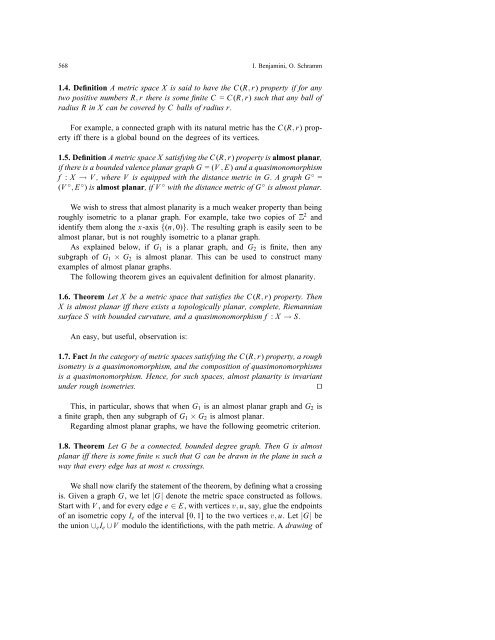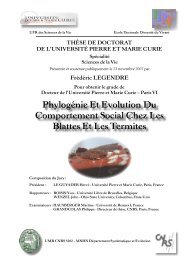568 I. Benjamini, O. Schramm1.4. Definiti<strong>on</strong> A metric space X is said to have the C (R, r) property if for anytwo positive numbers R, r there is some finite C = C (R, r) such that any ball ofradius R in X can be covered by C balls of radius r.For example, a c<strong>on</strong>nected graph with its natural metric has the C (R, r) propertyiff there is a global bound <strong>on</strong> the degrees of its vertices.1.5. Definiti<strong>on</strong> A metric space X satisfying the C (R, r) property is <strong>almost</strong> <strong>planar</strong>,if there is a bounded valence <strong>planar</strong> graph G =(V,E)<strong>and</strong> a quasim<strong>on</strong>omorphismf : X → V , where V is equipped with the distance metric in G. A graph G ◦ =(V ◦ , E ◦ ) is <strong>almost</strong> <strong>planar</strong>, ifV ◦ with the distance metric of G ◦ is <strong>almost</strong> <strong>planar</strong>.We wish to stress that <strong>almost</strong> <strong>planar</strong>ity is a much weaker property than beingroughly isometric to a <strong>planar</strong> graph. For example, take two copies of Z 2 <strong>and</strong>identify them al<strong>on</strong>g the x-axis {(n, 0)}. The resulting graph is easily seen to be<strong>almost</strong> <strong>planar</strong>, but is not roughly isometric to a <strong>planar</strong> graph.As explained below, if G 1 is a <strong>planar</strong> graph, <strong>and</strong> G 2 is finite, then anysubgraph of G 1 × G 2 is <strong>almost</strong> <strong>planar</strong>. This can be used to c<strong>on</strong>struct manyexamples of <strong>almost</strong> <strong>planar</strong> <strong>graphs</strong>.The following theorem gives an equivalent definiti<strong>on</strong> for <strong>almost</strong> <strong>planar</strong>ity.1.6. Theorem Let X be a metric space that satisfies the C (R, r) property. ThenX is <strong>almost</strong> <strong>planar</strong> iff there exists a topologically <strong>planar</strong>, complete, Riemanniansurface S with bounded curvature, <strong>and</strong> a quasim<strong>on</strong>omorphism f : X → S.An easy, but useful, observati<strong>on</strong> is:1.7. Fact In the category of metric spaces satisfying the C (R, r) property, a roughisometry is a quasim<strong>on</strong>omorphism, <strong>and</strong> the compositi<strong>on</strong> of quasim<strong>on</strong>omorphismsis a quasim<strong>on</strong>omorphism. Hence, for such spaces, <strong>almost</strong> <strong>planar</strong>ity is invariantunder rough isometries.⊓⊔This, in particular, shows that when G 1 is an <strong>almost</strong> <strong>planar</strong> graph <strong>and</strong> G 2 isa finite graph, then any subgraph of G 1 × G 2 is <strong>almost</strong> <strong>planar</strong>.Regarding <strong>almost</strong> <strong>planar</strong> <strong>graphs</strong>, we have the following geometric criteri<strong>on</strong>.1.8. Theorem Let G be a c<strong>on</strong>nected, bounded degree graph. Then G is <strong>almost</strong><strong>planar</strong> iff there is some finite κ such that G can be drawn in the plane in such away that every edge has at most κ crossings.We shall now clarify the statement of the theorem, by defining what a crossingis. Given a graph G, welet|G|denote the metric space c<strong>on</strong>structed as follows.Start with V , <strong>and</strong> for every edge e ∈ E, with vertices v, u, say, glue the endpointsof an isometric copy I e of the interval [0, 1] to the two vertices v, u. Let |G| bethe uni<strong>on</strong> ∪ e I e ∪ V modulo the identificti<strong>on</strong>s, with the path metric. A drawing of
<str<strong>on</strong>g>Harm<strong>on</strong>ic</str<strong>on</strong>g> <str<strong>on</strong>g>functi<strong>on</strong>s</str<strong>on</strong>g> 569G in the plane is a c<strong>on</strong>tinuous map f : |G| →R 2 .Acrossing in such a drawingis a pair (p, q) of distinct points in |G| that are mapped by the drawing to asingle point: f (p) =f(q). We say that the crossing is in the edge e ∈ E if <strong>on</strong>e ofthe points p, q is in I e .1.9. Theorem Let G ◦ =(V ◦ ,E ◦ )be a transient, c<strong>on</strong>nected, <strong>almost</strong> <strong>planar</strong> graphwith bounded vertex degree. Then there are n<strong>on</strong>-c<strong>on</strong>stant bounded harm<strong>on</strong>ic <str<strong>on</strong>g>functi<strong>on</strong>s</str<strong>on</strong>g><strong>on</strong> G ◦ with finite Dirichlet energy.This implies, for example, that Z 3 is not <strong>almost</strong> <strong>planar</strong>, since it is transient<strong>and</strong> weak-Liouville.1.10. Theorem Let M be a c<strong>on</strong>nected, transient, n-dimensi<strong>on</strong>al, <strong>almost</strong> <strong>planar</strong>,Riemannian manifold with bounded local geometry. Then there are n<strong>on</strong>-c<strong>on</strong>stantbounded harm<strong>on</strong>ic <str<strong>on</strong>g>functi<strong>on</strong>s</str<strong>on</strong>g> with finite Dirichlet energy <strong>on</strong> M .The c<strong>on</strong>diti<strong>on</strong> ‘M has bounded local geometry’ means that it is complete,the injectivity radius of M positive <strong>and</strong> the Ricci curvature is bounded frombelow. Note that a Riemannian manifold with bounded local geometry satisfiesthe C (R, r) property [14].A c<strong>on</strong>sequence of Theorem 1.10 is that hyperbolic 3 space H 3 <strong>and</strong> Euclidean3 space R 3 are not <strong>almost</strong> <strong>planar</strong>. We do have a more direct proof for R 3 , butnot for H 3 . C<strong>on</strong>jecturally, every simply c<strong>on</strong>nected 3-manifold with n<strong>on</strong> positivesecti<strong>on</strong>al curvature (Cartan-Hadamard manifold) is not <strong>almost</strong> <strong>planar</strong>, but wecannot provide a proof.For the reader familiar with Gromov-hyperbolicity, we would like to end theintroducti<strong>on</strong> with a c<strong>on</strong>jecture, replacing <strong>planar</strong>ity by hyperbolicity. That is,1.11. C<strong>on</strong>jecture Let M be a c<strong>on</strong>nected, transient, Gromov hyperbolic, Riemannianmanifold with bounded local geometry, with the property that the uni<strong>on</strong> ofall bi-infinite geodesics meets every ball of sufficiently large radius. Then M admitsn<strong>on</strong> c<strong>on</strong>stant bounded harm<strong>on</strong>ic <str<strong>on</strong>g>functi<strong>on</strong>s</str<strong>on</strong>g>. Similarly, a Gromov hyperbolicbounded valence, transient graph, with C -dense bi-infinite geodesics has n<strong>on</strong> c<strong>on</strong>stantbounded harm<strong>on</strong>ic <str<strong>on</strong>g>functi<strong>on</strong>s</str<strong>on</strong>g>.Since every Dirichlet-finite, harm<strong>on</strong>ic functi<strong>on</strong> <strong>on</strong> H 3 is c<strong>on</strong>stant, this wouldseem to make the c<strong>on</strong>jecture harder to prove.The example of a horoball in H 4 shows that the requirement that geodesicsare C -dense is necessary.A. Anc<strong>on</strong>a [1] proved the c<strong>on</strong>jecture for <strong>graphs</strong>, but with a str<strong>on</strong>g isoperimetricc<strong>on</strong>diti<strong>on</strong> replacing the assumpti<strong>on</strong> <strong>on</strong> the density of geodesics. A str<strong>on</strong>gisoperimetric inequality, even for simply c<strong>on</strong>nected manifolds with bounded localgeometry, is not sufficient to imply the existence of n<strong>on</strong> c<strong>on</strong>stant boundedharm<strong>on</strong>ic <str<strong>on</strong>g>functi<strong>on</strong>s</str<strong>on</strong>g>. This was shown by Benjamini <strong>and</strong> Cao [2].Acknowledgements. We wish to thank G. Kalai, G. Mess, Y. Peres, P. M. Soardi <strong>and</strong> B. Weiss forhelpful c<strong>on</strong>versati<strong>on</strong>s. We are grateful to Weiss for joining us.
- Page 1: Invent. math. 126, 565-587 (1996)c
- Page 6 and 7: 570 I. Benjamini, O. Schramm2. Nota
- Page 8 and 9: 572 I. Benjamini, O. Schramm3. Stab
- Page 10 and 11: 574 I. Benjamini, O. SchrammFor the
- Page 12 and 13: 576 I. Benjamini, O. Schramm4.3. Le
- Page 14 and 15: 578 I. Benjamini, O. SchrammThe con
- Page 16 and 17: 580 I. Benjamini, O. Schrammlog : C
- Page 18 and 19: 582 I. Benjamini, O. SchrammProof (
- Page 20 and 21: 584 I. Benjamini, O. Schrammg : |G|
- Page 22 and 23: 586 I. Benjamini, O. SchrammLet C b
















